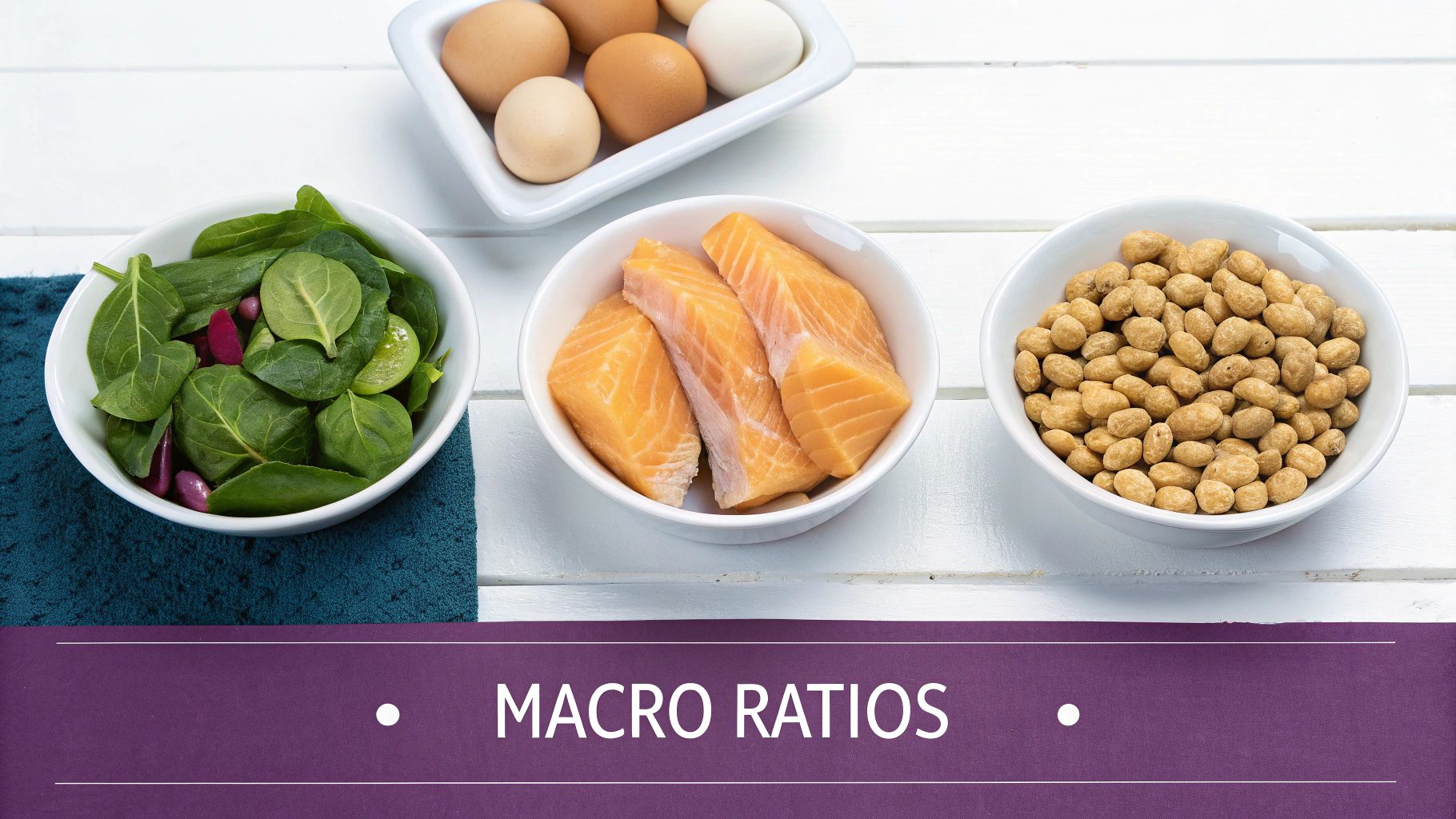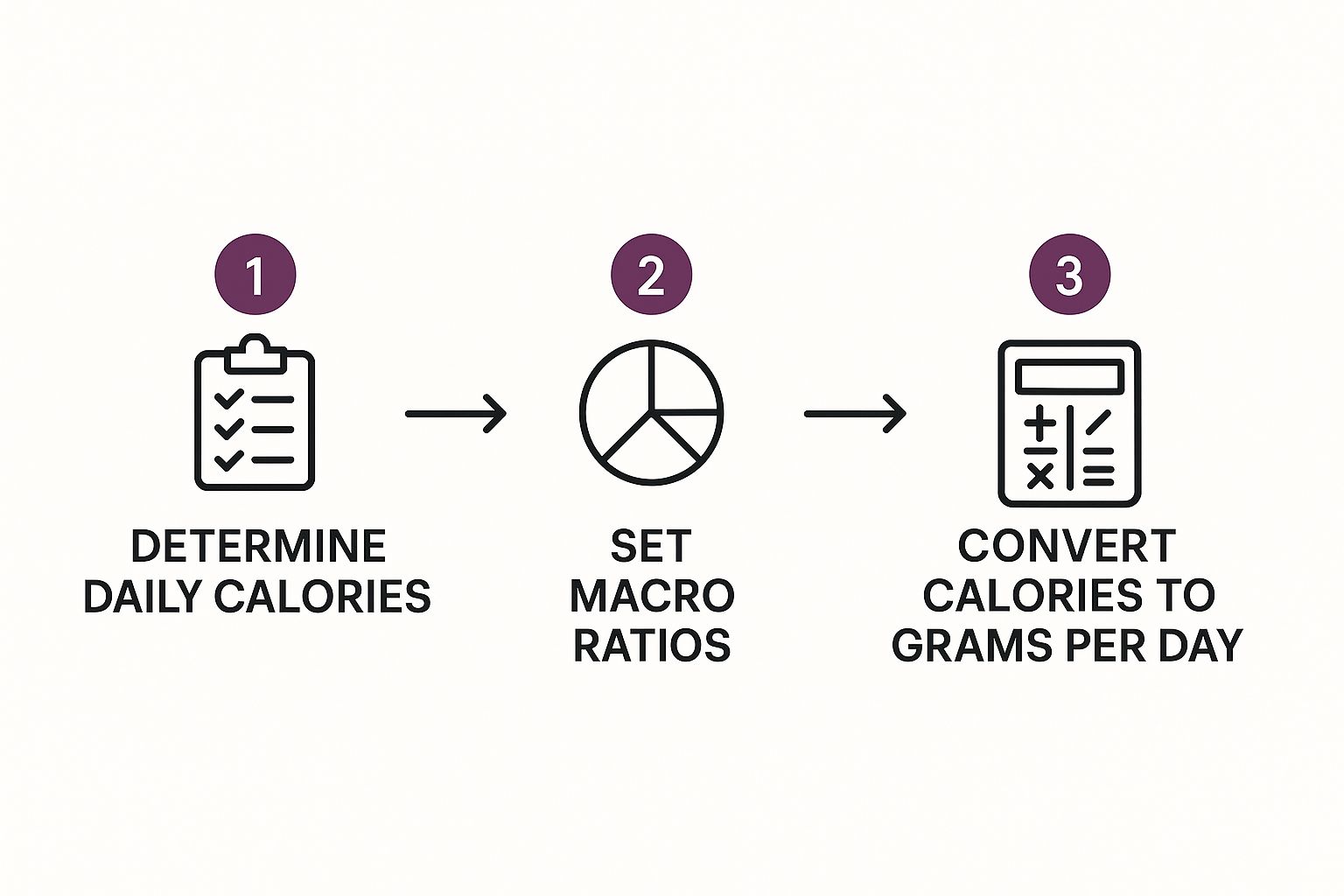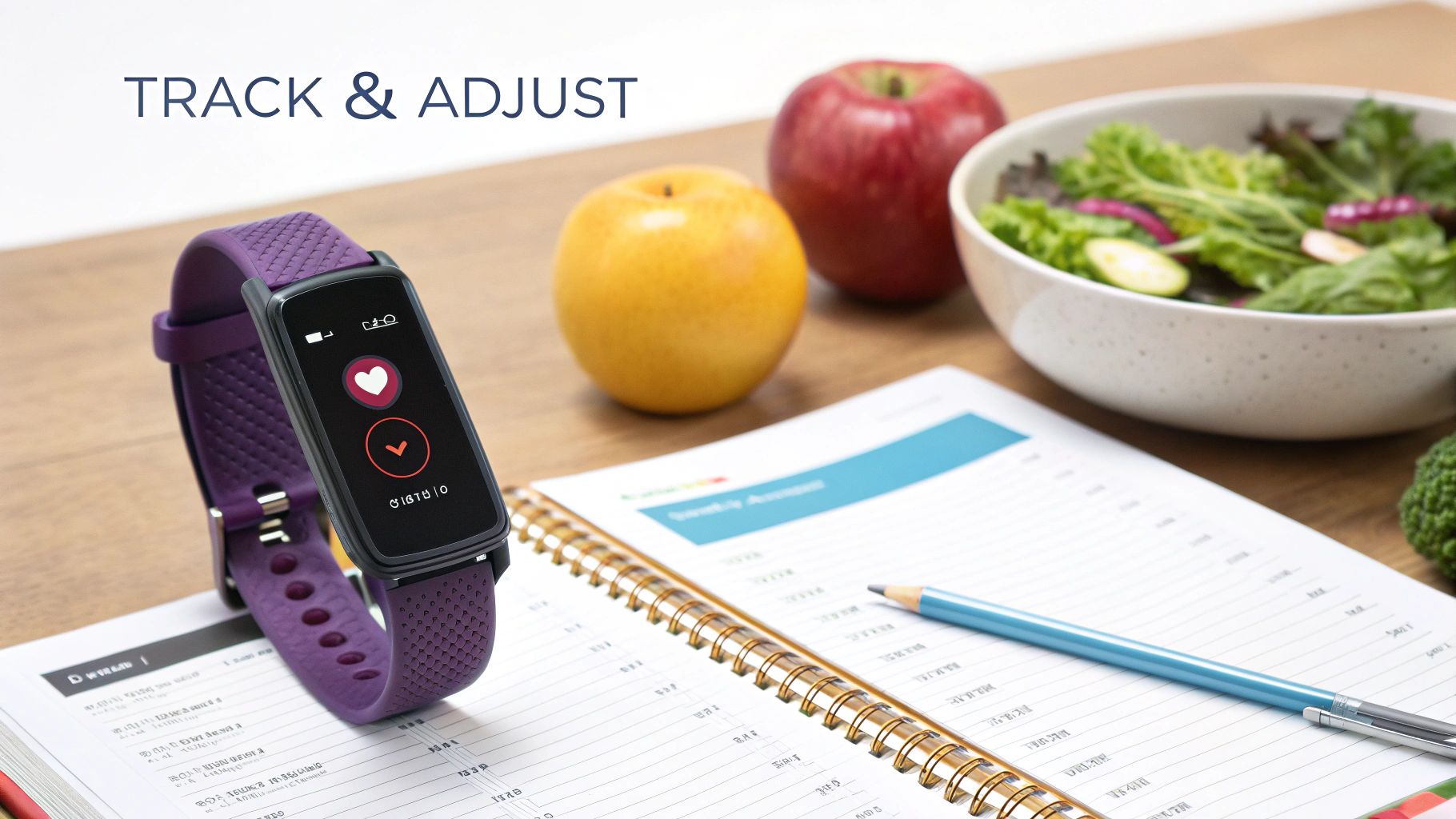
How to Calculate Macros for Your Fitness Goals
Calculating your macros is a strategic way to fuel your body for specific fitness goals, whether that's building muscle, shedding fat, or just feeling more energetic.
It’s a step beyond basic calorie counting. Instead of just focusing on a single number, you’re looking at the quality and composition of the calories you consume.
Your Foundation for Smart Macro Counting
This approach personalizes your nutrition by understanding that each macronutrient plays a vital role. These are the "big three" building blocks of any effective diet.
- Protein: Essential for building and maintaining tissue, supporting muscle growth, and keeping you feeling full.
- Carbohydrates: Your body's most efficient energy source, powering you through tough workouts and keeping your brain sharp.
- Fats: Critical for producing hormones, absorbing vitamins, and supporting your overall health from the inside out.
Why This Approach Works
Balancing these three gives your body exactly what it needs to perform, recover, and change. Slashing calories without considering macros can lead to muscle loss, low energy, and frustrating plateaus.
For instance, getting enough protein is key to holding onto muscle mass when you're in a calorie deficit, which is crucial for sustainable fat loss. You can dive deeper into how a calorie deficit works in our detailed guide.
This method is built on decades of nutritional science. Early guidelines evolved into the Dietary Reference Intakes (DRIs), which give us foundational macro percentages—like 45-65% from carbs and 10-35% from protein—that still influence modern nutrition.
To start, you only need two simple tools: a digital food scale for accuracy and a tracking app to log your meals. These tools remove the guesswork and empower you to take precise control of your nutrition.
Setting Your Daily Protein Target
After you determine your daily calorie goal, protein is the first macro to lock in. It's the cornerstone of your diet, driving muscle repair, growth, and retention.

Calculating your protein needs based on your body weight is far more effective than using a random percentage. It connects your intake directly to your body's actual demand.
Finding Your Protein Sweet Spot
Your specific fitness goal determines the right protein multiplier. A person maintaining their physique needs less than someone actively trying to build muscle.
Here’s a quick breakdown to get started:
- For Fat Loss & Muscle Preservation: Aim for 0.8 to 1.2 grams of protein per pound of body weight (1.8 to 2.7 g/kg). High protein helps preserve muscle in a calorie deficit.
- For Muscle Gain: The sweet spot is 0.7 to 1.0 grams of protein per pound of body weight (1.5 to 2.2 g/kg). This provides the necessary building blocks for growth.
- For General Health & Maintenance: A target of 0.7 to 0.8 grams per pound (1.5 to 1.8 g/kg) is sufficient for daily needs.
For example, if you weigh 180 pounds and want to build muscle, using a multiplier of 1.0 gram is a simple and effective starting point.
The Math:
180 lbs (Your Weight) x 1.0 g (Multiplier) = 180 grams of protein per day
This gives you a solid, concrete number to aim for daily.
How to Actually Hit Your Protein Goal
Hitting a high protein target with whole foods alone can be challenging. Smart supplementation is a simple hack to meet your daily goal without adding excess carbs or fats.
A single scoop of a high-quality whey protein like DietExerciseShop's Premium Whey Protein can provide an extra 20-25 grams of pure protein. It's perfect for a post-workout shake or to boost a morning smoothie, ensuring your body gets what it needs to recover and grow stronger. This product is a staple for anyone serious about their fitness and nutrition.
Balancing Your Fats and Carbohydrates
With your protein target set, it's time to allocate the rest of your calories between fats and carbohydrates. This isn't about restriction; it's about strategic fueling.
Dietary fats are not the enemy. They are essential for hormone production and absorbing key vitamins.

A great starting point for most people is to get 20% to 30% of total daily calories from healthy fats. This supports crucial bodily functions without taking too many calories from your other macros.
Nailing Down Your Daily Fat Intake
Turning that percentage into a trackable number is a quick two-step process. First, find the calorie amount, then convert it to grams.
Let's use a 2,200-calorie daily goal. Aiming for 25% of calories from fat, the math is:
- Find Your Fat Calories: 2,200 calories x 0.25 = 550 calories from fat.
- Convert to Grams: 550 calories ÷ 9 (fat has 9 calories/gram) = ~61 grams of fat per day.
This gives you a clear, actionable target for your daily fat intake.
Figuring Out Your Carbohydrate Goal
The final piece of the puzzle is carbohydrates, your body's primary energy source. Whatever calories are left in your daily budget go here.
Continuing with our 2,200-calorie example, we've already allocated:
- Protein: 180g = 720 calories (180g x 4 cal/g)
- Fat: 61g = 550 calories (61g x 9 cal/g)
Putting It All Together:
2,200 (Total) - 720 (Protein) - 550 (Fat) = 930 remaining calories for carbs.
Now, convert those calories into grams.
- Carb Grams: 930 calories ÷ 4 (carbs have 4 calories/gram) = ~233 grams of carbs per day.
This fill-in-the-blanks approach ensures every calorie has a specific job.
For an extra push during intense workouts, a clean energy source is key. The Diet Exercise Shop Energy & Focus Blend is designed to boost performance without derailing your macro plan. It’s the perfect complement to a disciplined diet and exercise routine, helping you maximize every session.
Let's Put This Into Practice: A Real-World Example
Let's walk through a complete example to see how these numbers come together.
Meet 'Alex'. Alex weighs 165 pounds, works a desk job, but trains hard at the gym four times a week to build muscle. Our goal is to create a starting nutrition plan for him.
First, Alex's Daily Calorie Target
Before macros, we need an energy budget. For someone like Alex, who is moderately active and aiming for muscle gain, about 16 calories per pound of body weight is a good starting point.
- The Math: 165 lbs (Alex's Weight) x 16 (Multiplier) = 2,640 calories per day
This provides a slight calorie surplus, perfect for fueling workouts and building muscle without excess fat gain.
Next, We Set The Macro Split
With a 2,640 calorie goal, we can set the macros. We start with protein, which is critical for muscle growth. A solid rule is 1 gram of protein per pound of body weight.
-
Protein: 165 lbs x 1.0 g = 165 grams of protein
- This accounts for 660 calories (165g x 4 cal/g).
Next, we calculate fats. We'll set Alex at 25% of total calories to support hormone function.
-
Fat: 2,640 calories x 0.25 = 660 calories from fat.
- Dividing by 9 calories per gram: 660 ÷ 9 = ~73 grams of fat.
Finally, the rest of the calorie budget goes to carbohydrates—the fuel for intense training.
-
Carbs: 2,640 (Total) - 660 (Protein) - 660 (Fat) = 1,320 calories for carbs.
- Dividing by 4 calories per gram: 1,320 ÷ 4 = 330 grams of carbs.
This simple process provides a clear plan.

The logic is simple: establish total energy needs, set protein and fat based on goals, and let carbs fill the rest.
Alex's Final Daily Macro Plan:
- Calories: 2,640
- Protein: 165g
- Fat: 73g
- Carbohydrates: 330g
This gives Alex an actionable daily target. Standardized nutrition labeling makes this tracking possible. If you're curious, you can learn more about the history of nutrition labeling and its impact on dietary tracking.
By the way, if you're working hard like Alex, look the part. Check out our collection of fitness-themed shirts and sweaters at the Diet & Exercise Shop, designed for people who are proud of their journey.
Tracking and Adjusting Your Macros for Long-Term Success
Your initial macro numbers are just a starting point. The real skill is in tracking your progress and making smart adjustments based on your body's feedback.

You need two essential tools: a reliable digital food scale and a tracking app. "Eyeballing" portions leads to stalled progress. Accuracy is your best friend.
The Diet & Exercise Shop Precision Digital Food Scale is designed for precise measurements, ensuring what you log is what you eat. It’s a small investment that makes a massive difference in your results. For tips on how to use it effectively, check out our Diet & Exercise YouTube channel. Our scale is a must-have for anyone serious about tracking macros accurately.
Knowing When It's Time for a Change
Once you're tracking consistently, pay attention to your body's feedback. Give your body at least two to three weeks to adapt to new macro targets before making changes.
Look for these common signals to adjust:
- Weight loss has stalled for two weeks or more. This is a classic plateau.
- You feel constantly drained during workouts. This often means you need more fuel, usually from carbs.
- You're gaining weight too quickly while trying to build muscle. This suggests you're gaining more fat than desired.
How to Make Smart Macro Adjustments
When you make a change, think small and strategic. Big, drastic cuts can backfire. The goal is the smallest effective change.
My number one rule: Never cut your protein. Adjust calories by tweaking your carbohydrate and fat intake.
If your weight loss has flatlined, create a slightly larger deficit by reducing daily calories by about 100-200.
You can do this by:
- Lowering Fats: Cut 11-22 grams of fat from your daily total.
- Lowering Carbs: Trim 25-50 grams of carbs from your daily total.
This flexible approach allows you to make changes that suit your preferences and energy needs. To master this, you need to be confident in reading food labels. Sharpen your skills with our guide on how to read nutrition labels correctly.
Common Questions About Macro Counting
It's natural to have questions when you start counting macros. Getting these answered early can make the process much smoother.
Let's dive into some common questions.
Do I Have to Hit My Macros Perfectly Every Day?
No. Chasing perfection leads to frustration. Consistency over perfection is what matters.
Aim for a reasonable range: within 5-10 grams of your protein and carb goals, and within 2-5 grams of your fat target. If you can do that most days, you're on the right track.
Prioritize hitting your total daily protein and overall calorie numbers first, as these drive the most significant changes.
What Is the Best Macro Split for Fat Loss?
There's no single magic ratio. The best split depends on your body, activity level, and food preferences.
However, a great starting point for fat loss is a high-protein, moderate-fat, and moderate-carb split. A common breakdown is:
- 40% Protein: Keeps you full and preserves muscle.
- 30% Fat: Essential for hormone production and health.
- 30% Carbs: Provides energy for workouts and daily life.
Remember, a consistent calorie deficit is the number one rule for fat loss.
Should I Count Carbs from All Vegetables?
Don't drive yourself crazy weighing every piece of lettuce. For non-starchy, high-fiber veggies—like leafy greens, cucumbers, and bell peppers—the calorie count is negligible. Eat them freely.
Focus your tracking on starchy, carb-dense vegetables like potatoes, corn, and peas. This makes the process much more sustainable.
How to Track Macros When Eating Out
Eating out is manageable with practice. Chain restaurants often post their nutrition info online, making it easy to log.
For local restaurants, you'll need to estimate. Find a similar meal from a chain restaurant in your tracking app and use that as a baseline.
When in doubt, overestimate slightly, especially on fats from cooking oils and sauces. A good guess is always better than not tracking at all.
At DietExerciseShop, we believe a great mindset is as important as the right supplements and gear. Our collection of stylish fitness apparel, like our comfy shirts and sweaters, is designed to keep you motivated. Our science-backed supplements, from protein to pre-workouts, are formulated to help you achieve your goals faster. Check out the full collection to find everything you need for your fitness journey.
